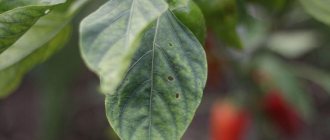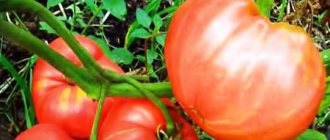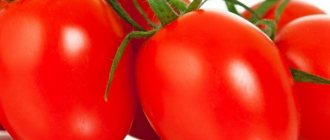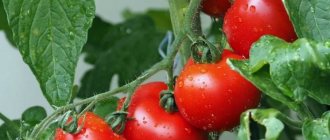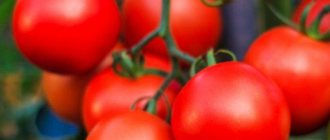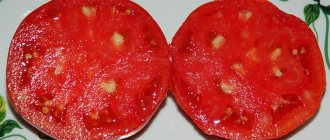Raspberry miracle is a whole series of hybrid tomatoes of 15 varieties. Tomatoes have attractive appearance and pleasant taste, and their ease of care makes them a real boon for vegetable growers and consumers. Before planting this variety, familiarize yourself with its characteristics and study the “pitfalls” (if any).
Raspberry Ring
The Raspberry Ring tomato is distinguished by its early ripening. It is zoned in all regions. Any growing method is suitable for it. This is a hybrid tomato, resistant to infections, adverse weather conditions, determinant:
- fruits are flat-round, fleshy;
- average weight 150 g, but gardeners grow larger tomatoes, 400 g;
- productivity – 4.5 kg/m2. When planting seedlings in the ground, certain requirements are observed. 3-4 bushes are planted per 1 m2.
The bushes grow up to 1.2 m. Later they stop their development. They are tied to trellises, pinched, and formed into 1-2 stems. The first brush comes out above the 4th leaf.
The next peduncles emerge after 1-2 leaves. Up to 6 ovaries appear on each brush. Gardeners count up to 7 levels on one stem.
Advantages and disadvantages of a hybrid
The unpretentious, productive form is distinguished by the excellent taste of its fleshy fruits. Their commodity and transportation indicators ensure the cost-effectiveness of purchasing seeds. The fruits are resistant to cracking, and in some cases are suitable for preservation as a whole.
Many gardeners choose tomatoes from the Raspberry Miracle collection for guaranteed germination in any climate zone, high yield and taste, and relative unpretentiousness. Summer residents say resistance to late blight is an advantage of the “Raspberry Miracle”.
Disadvantages among gardeners include the likelihood of bushes breaking off due to the large number of fruits weighing up to 800g, and the unsuitability of some large representatives of the “Raspberry Miracle” for whole-fruit preservation. The main disadvantage is considered to be a gradual decrease in the average weight of fruits from harvest to harvest.
All reviews about the Raspberry Miracle note high yields and an interesting taste. Summer residents report that the size and shape of vegetables depends on the series. Many of them can preserve whole fruits, sorting them by size. Cultivators emphasize the high cost of seeds, but they pay for themselves after selling the crop.
Gardeners emphasize the long-term preservation of seed germination. Experts recommend storing the collected fruits in a refrigerator or cellar at a humidity of 80% and a temperature of +5 to +12 degrees.
Dawn
Tomato Raspberry Dawn – varietal. Seed material for the next season is collected independently. Throughout the growing season, seedlings are treated against infections and insects.
The fruits begin to ripen after 115-118 days. Tomatoes are grown both in open and protected ground. The Rassvet variety is suitable for all regions:
- heart-shaped fruits;
- a weight of 350-400 g is considered marketable. In practice, gardeners receive tomatoes up to 600-800 g;
- yield – 7.9 kg/m2.
The plant is indeterminate. There are no more than 2 bushes per 1 m2. The first peduncle emerges above the 9th leaf. The next ones appear after 2 leaves. Up to 8 ovaries are formed on each hand, but they do not ripen at the same time. Up to 7-9 clusters can develop on one stem.
Origin and main characteristics of the series
The work on developing tomato varieties, united under the name “Raspberry Miracle,” took more than 12 years and culminated in the creation of three series, each of which includes five varieties of the crop. In 2014, this collection won a gold medal at the All-Russian Agricultural Exhibition. All varieties included in the line were included in the State Register (the first series - in 2015, and the second and third - in 2022). Today their seeds are sold by the NGO “Gardens of Russia” under the new general name “Golden Raspberry Miracle”.
The following video will tell you more about this:
Judging by the descriptions offered by the manufacturer, the tomatoes in this collection have the following properties:
- the possibility of cultivation throughout the country, both in open and protected ground (depending on the climatic characteristics of the region);
- resistance to unfavorable growing conditions;
- large-fruited;
- beauty and high taste of fruits;
- low susceptibility to major tomato diseases (including late blight and various rots);
- consistently high yields.
As the name implies, the fruits of all varieties of “Raspberry Miracle” tomatoes are painted in a bright crimson color. According to reviews from summer residents, most varieties form ovaries together and successfully “feed” the crop even with sudden temperature changes or insufficient watering.
Tomato seedlings of the “Raspberry Miracle” series are planted in the garden 60-65 days after the emergence of full shoots
Cultivating Raspberry Miracle tomatoes is no different from cultivating other varieties of tomatoes. In the middle zone, seeds are sown in pre-prepared soil in February-March. Sprouts appear within a week. Seedlings are planted in a greenhouse or in a garden bed no later than 60-65 days from full germination (otherwise there is a risk of “pulling” the plants). All varieties of “Raspberry Miracle” develop according to the determinant type, so the bushes are formed into 2-3 stems, leaving no more than five flower clusters on each of them and tying them to supports so that the trunks do not break when large fruits ripen. To achieve maximum yield, plants are periodically fed with solutions of ammonium nitrate, superphosphate, wood ash or complex mineral fertilizer.
Tomato bushes are tied to supports in advance so that the trunks do not break when large fruits ripen
The fruits of most varieties of tomatoes from the Raspberry Miracle collection can be used both for fresh consumption and for processing. They have a durable skin that is not prone to cracking and dense, tasty flesh. In large-fruited varieties, the largest tomatoes ripen on the lower clusters, and specimens collected from the upper parts of the plants are medium in size and quite suitable for whole-fruit canning.
The fruits have a rich crimson color
Tomato seeds included in the “Raspberry Miracle” line are produced by NPO Gardens of Russia (at the time of registration of varieties in the State Register it was called LLC NPO Garden and Vegetable Garden). The quality of the seed is beyond doubt, but its implementation has specifics that are not entirely comfortable for gardeners. Firstly, the names of the varieties on the seed packages are marked “F1”, but in the descriptions posted on the company’s website they appear as both varieties and hybrids, which misleads buyers.
In fact, all varieties of Raspberry Miracle tomatoes are registered in the State Register as varieties (!). This means that seeds collected from “their” plants are quite suitable for sowing.
Secondly, “Raspberry Miracle” tomato seeds are sold exclusively in sets (series) of 5 varieties each. For many buyers, this is inconvenient: few people will agree to allocate a significant area exclusively for raspberry tomatoes, and investing in seed material, the use of which will have to be extended over several years, is also not suitable for everyone. Such features of the sale of seeds (even of the highest quality) undoubtedly harm the reputation of the manufacturer.
Giant
The giant is an early, varietal tomato. It is recommended for all regions, but it is necessary to choose the most suitable growing method. The tomato develops well both in the open garden and in the greenhouse. The plant is determinate, tall:
| № | Helpful information |
| 1 | the fruit is round, there is no ribbing |
| 2 | weight – 200-300 g. Individual berries gain up to 600 g |
| 3 | 2-3 bushes are planted per 1 m2. They collect 5.9 kg |
The branches are tied together with the stalk. Additionally, supports are installed under the hands. According to gardeners, the stem bends under the weight of the fruit, but is not injured. Tomatoes are grown in a sunny area. Fertilizers are introduced throughout the growing season.
Raspberry tomatoes gain sweetness only in sunny areas, but it is recommended to cover them with a protective net to protect them from intense ultraviolet radiation. The fruits may be baked. When exposed to sunlight, green fibrous areas may appear in the pulp.
The best varieties of tomatoes based on the results of 2017
Although, let's be honest, the summer was cold and rainy, there was no warm weather, especially in central Russia. Nevertheless, all the serious problems associated with difficult weather conditions, which became a real test for many, are behind us. However, we have some positive results to tell.
We present the best varieties of tomatoes that you can take note of and start searching for planting material from well-known agricultural companies.
Universal tomato Lyubasha-F1. Love at first harvest
The following tomato varieties are the most popular in terms of weather tolerance, disease resistance and excellent yield. They were the ones who passed the tests and passed them with honor in Central Russia.
The best varieties of yellow and orange tomatoes
A short digression that will help you learn more about the yellow and orange fruits of tomatoes.
First, it is a powerful antioxidant containing large amounts of beta-carotene, which provides the body with cardiovascular support.
Secondly, the vitamin A contained in them acts as a prevention of cancer, changes in the organs of vision, in particular cataracts. Necessary for strengthening the immune system, bones, and for healthy skin and hair. The fruits of “sun apples” are recommended for impaired salt metabolism and excess weight.
These include several varieties that are most suitable for cultivation in central Russia.
Orange tomatoes best varieties
Many gardeners approve of the Orange Banana variety; "Orange Giant"; "Bison orange"; "Orange Miracle"; "Orange Elephant"; "Orange Strawberry"
Tomato Golden Heart
The first places in terms of yield in bad weather conditions of the 2017 season were won by:
- “Golden Heart” is an indeterminate variety, high-yielding with medium ripening, the height of the bush (1.8 m) necessitates staking to a support. The shape of the fruit is round, ribbed, pointed at the bottom, with a sweetish taste and delicate aroma. Easy to grow, resistant to diseases, transportable.
- “Altai Orange” - fruits are round, slightly flattened, large, up to 350 g or more. The pulp is tender, sugary. Used for pickling, juicing, freezing and making pasta. The bush is tall, powerful, spreading. Needs support and foliage formation. It is grown in open ground and performs well in greenhouses.
- “Orange” is one of the best yielding varieties, fruit ripening (90–150 g), medium-term with the appearance of tomatoes on the hundredth day from the moment of germination. The shape is spherical, slightly flattened on the sides. The bush is compact and convenient for greenhouses. High yields per 1 sq. m. up to 10 kg, they say that the variety is resistant to most diseases. According to gardeners, the variety of crop is super-determinant.
Yellow tomatoes, the best varieties for the outgoing 2022 season
Favorites of the Honey Spas beds; "Persimmon"; "Orange"; “Honey Drop” is a variety of cherry tomatoes that has long won the hearts of gardeners.
The best rated are:
- “Golden Bull” - fruits of indeterminate type, large (up to 500 g), fleshy, ripening in 3–3.5 months. The shape is flat-round, ribbed. During the period of biological maturity, a crimson-red spot is noticeable from below in the central part of the tomato. The clusters have 4–5 fruits. Such a load requires tying the plant to the trellis.
- Particularly - an indeterminate, productive, large-fruited yellow favorite with positive qualities in cold weather conditions. The variety is mid-season, ripening occurs on days 110–115 from the beginning of seedling emergence. The fruits, reaching a weight of 300–400 g (600–800 g under good agronomic conditions), do not crack, are fleshy and sweet. With a high content of beta-carotene and lower acidity, unlike its red counterparts. The variety performed well in greenhouse conditions and without film coating (in open ground) until the first frost. “Honey Giant” is resistant to mechanical damage, therefore it tolerates transportation well and is stored for a long time. Knowing these qualities, farmers grow tomatoes for sale in large quantities. The variety is not afraid of the cataclysms of cold summer. Tall bushes with a large number of brushes and large fruits require support and formation into 2 stems.
It is important! Yellow tomatoes do not cause allergic reactions like red-fruited varieties.
The best varieties of black tomatoes
Exotic black tomatoes are rapidly rising to the peak of popularity. They attract not only with their color from chocolate brown to black-brown, but also with a piquant taste with a fruity tint and a high content of sugary substances.
Black tomatoes, the best varieties of which were rated by gardeners in 2017: “Japanese truffle”; "Black Cherry"; "Chernomor"; "Black bunch"; "Black Moor"; "Black Baron"; "Black Elephant"
Among the “dark-skinned” tomatoes that breeders have adapted to the Russian climatic conditions of the Middle Zone, “Black Prince” stands out.
Tomato Black Prince
An indeterminate variety, a Chinese mid-early, dessert, productive variety, from which 4 kg of tomatoes are obtained per bush. With round fruits (from 100 to 500 g) of burgundy-violet color, a pleasant sour-sweet taste and excellent ability to resist late blight. To enjoy black tomatoes, it is recommended to grow them in greenhouses. Plants planted in open ground if there is a threat of even light frosts must be covered with film.
The best varieties of raspberry tomatoes
The best varieties of pink tomatoes - tasting and analyzing. Summer residents have long loved raspberry-colored tomatoes for their excellent qualities for use in fresh salads and their beauty. Pay attention to the best varieties of raspberry tomatoes that adapt well to the lands of Central Russia: “Raspberry Ball”; “Crimson Elephant”; “Pink Arrow”; "Amateur pink."
The pedestal in terms of survival and productivity was rightfully taken by the early-ripening fruitful variety “Batyanya”. It was created by Siberian breeders. The fruits are large (reach 500 g), pink-raspberry in color, with excellent taste. The surface is glossy. The plant reaches a height of two meters. Tomatoes are grown in a greenhouse, forming bushes from 2 main shoots.
2017: the best varieties of cherry tomatoes
At the end of the last century, cherry tomatoes began to be grown, thanks to Israeli breeders. And most recently in Russia. Domestic gardeners fell in love with the kids.
“Cherry” means cherry, and this name suits the small fruits of the plant. The only misconception is that cherry tomatoes are decorative. Small tomatoes are beautiful, decorate gardens and are recognized by chefs. They are tasty and healthy, thanks to the large amount of vitamins, nutrients and sugars. Breeders have managed to develop varieties with blueberry, melon and raspberry flavors.
Pay attention to the following varieties: “Sun Gold”; "Super Suite 100"; "Ira F1"; "Doctor Green Frosted", "Yellow Date".
- At the end of last year, the Ampelny tomato, a mixture of Thumbelina and Vodopad cherry tomatoes, turned out to be the most persistent and productive. A combination of early ripening varieties with a ripening period of 100–110 days. Medium-sized, indeterminate plants, with ovaries in a cluster of 15 to 20 fruits, weighing up to 20 g. 7–8 kg are collected from one square meter. These best varieties of cherry tomatoes are grown in tall barrels in hanging baskets. They will look beautiful on balconies and loggias. In both cases, summer residents and city residents will be satisfied with their taste.
The ampelous mixture of cherry varieties is loved for its ease of care, which does not require pinching and formation of bushes. Only yellowed and dry leaves are removed. For productivity, plants need a capacity of at least 5 liters, ideally 7 or 8 liters.
Farmer
Breeder Blokin-Mechtalin V.I. The Farmer created the tomato, which is distinguished by its small fruits. This characteristic is unusual for raspberry tomatoes. Fruits are suitable for canning:
- the berry is round, with a smooth surface;
- average weight 50-60 g;
- productivity is high, more than 10 kg/m2. This indicator is observed when growing tomatoes in a greenhouse.
More on the topic: What varieties of white tomatoes are there?
The farmer is distinguished by early maturation. Tomatoes ripen in 90-100 days. The plant is a hybrid with good resistance to infections.
Landing
Seeds are sown from early March to early April. Select a nutritious loose soil mixture with a neutral pH (with instructions for tomatoes).
The depth of the damage is 1-1.5 cm.
Rules for caring for seedlings:
- irrigation with warm water 25-26 degrees;
- additional lighting (15-16 hours total day length for plants);
- feeding with Kemira, Krepysh 2 times before and after the dive.
At the age of 50-58 days, the bushes are transplanted into beds.
Malinka
The Malinka variety is distinguished by late ripening. Tomatoes begin to ripen in 125-130 days. They are used not only for salads, but also for canning. They have a dense shell that can withstand heat treatment. Berries can ripen for a long time in a cool and dark room:
- determinate, standard variety. He does not need stepsoning;
- the berry is round, the surface is smooth;
- weight – 100-130 g. The tomato is suitable for whole-fruit canning.
Raspberry is suitable for all regions. Any growing method is suitable for it. Seedlings must be treated with biofungicides, despite the fact that the plants have increased immunity. In this case, gentle means are used.
There is a variety called Kalinka-Malinka, but it is distinguished by red fruits. The tomato is sweet, without sourness. The fruits are suitable for pickling. The variety is mid-early, determinate, standard.
Heart
The Raspberry Heart variety is characterized by medium-early ripening. The plant is determinate. When grown in an open garden, 2-3 stems are produced. Greenhouse seedlings are left with 1 stem. Varietal culture. Gardeners can collect seed material themselves:
- heart-shaped berry;
- weight 250-330 g, but gardeners grow much larger tomatoes. The weight of individual fruits can reach 800 g;
- It is recommended to plant no more than 3-4 bushes per 1 m2. Up to 15 kg are collected from them.
The tomato is very sweet and beautiful, salad type. It is not used for pickling or storage. It is intended for quick consumption. It is grown on fertile soil. It is recommended to pre-enrich the garden bed with compost and apply biofertilizers.
Tomato care
The plant grows quickly. Leave 2 stems at a time, and cut off the remaining shoots as they appear. To increase productivity, do not forget about the standard set: regular watering, weeding, mineral fertilizing, weed removal, preventive measures against diseases and harmful insects.
Basic rules of care:
- Moisten the soil with drip irrigation.
- Loosen the soil after pre-moistening.
- Choose superphosphates as a top dressing.
- Fertilize the soil with manure, peat, and wood ash.
- Tie the stems to the trellis and other supports.
Watering tomatoes
For Raspberry Miracle tomatoes, use the drip irrigation method. Equip a tape system that will constantly maintain the moisture the root system needs for accelerated growth.
During the fruiting period, tomatoes need a lot of water - about 3.5 liters per 1 square meter. m. If they grow in a greenhouse, water them generously in the morning, in sunny weather. When growing outdoors, it is better to postpone watering to the evening so that the water does not evaporate quickly.
Weeding
To increase aeration rates, surface loosening of the soil is necessary after each watering. Do not allow a crust to form, otherwise the supply of oxygen to the soil will be disrupted and fruit growth and ripening will slow down.
Immediately after planting and for the next 7 days, loosen the soil to a depth of 12 cm, then no more than 8 cm. This is important so as not to damage the overgrown root system. The soil at the base of the bush should always be fluffy.
Mulching the soil (surface coating of the soil with special compounds) will help improve humidity and temperature.
Top dressing
For fertilizer, choose special complex preparations, tree resin, peat, humus, and manure. As a top dressing, dissolve dry superphosphate in water according to the instructions, which is especially important during the fruiting period (to increase productivity).
Bush formation
Move the bushes away from each other, do not plant them too closely, otherwise they will lack warmth and light. Tie tall bushes to a support during active growth throughout the growing season.
Timely pinching, pinching the growing point and forming bushes also increases the yield. It is better to immediately tear off the lower leaves close to the ground. This will enhance plant growth and prevent the development of fungus.
Harvest and storage
You can start harvesting in the summer months (June to August). The first fruits are the largest and go to sale. In the future, small tomatoes are used by gardeners for preservation. At a temperature of 13 degrees, the entire crop is harvested, as the taste deteriorates.
If the fruits are ripe, they can be stored for up to 3 days without compromising their integrity. If tomatoes need to ripen, they are kept in a warm, dry place for up to 7 days. Seeds for future seedlings are selected from large specimens. Shelf life – up to 10 years.
Rhapsody
Agro suggests trying the early, determinate variety Raspberry Rhapsody. It is suitable for all regions. It requires a sunny and fertile area. The fruit is large, high-yielding:
- flat-round berry, 200 g. Fruits of 350-400 g grow on the main part of the bush. Up to 7 ovaries are formed on one brush;
- When planting, no more than 3-4 bushes are placed per 1 m2. They bring more than 13 kg of tomatoes with commercial characteristics;
- The immunity of seedlings is supported by biofungicides and the introduction of fertilizing.
The Rhapsody variety is grown from seedlings 50-55 days old. After planting in the ground, the seedlings are given 2 weeks to adapt. After 1.5-2 months, the first fruits begin to ripen. They are large in size and weight, more than 600 g.
Third episode
There is another series of Raspberry Miracle tomatoes. It includes 5 hybrids:
- Raspberry hare is characterized by a 100-day ripening period, excellent fruiting in cool weather, juicy sweet fruits that have a round shape and weigh 0.6 kilos.
- Raspberry bogatyr is a high-yielding hybrid, characterized by a weight of ripening fruits of 0.6 - 0.8 kilos. This variety is easy to care for and ripens at any temperature. Reviews from gardeners agree on one thing: these tomatoes look like large raspberries. Another positive characteristic is early ripeness: the first harvest is harvested 90 days after planting the seedlings.
- Raspberry heart has the following features: high yield obtained from small bushes 60 - 80 centimeters high, an average ripening period of 90 days, heart-shaped tomatoes with sugar pulp and a weight of 250 grams. Most often, such vegetables are used by gardeners for canning.
- Raspberry surprise is distinguished by its developed root system and unpretentiousness. This variety was bred by selection for minimal involvement of the gardener in the process of crop growth. You can get the first harvest 95 days after planting the plant. Growing this variety allows you to get 400 grams of fleshy, juicy vegetables that have a round, flattened shape;
- Raspberry popsicle. Tomato seeds of this variety and the grown crop are characterized by unpretentiousness to weather conditions and tolerate prolonged rainfall and cold weather well. The average weight of tomatoes reaches 0.4 kilos, their ripening period is 80 - 105 days. The fruits are distinguished by their bright color and elongated shape.
This tomato complex was developed at the Scientific Institute located in Chelyabinsk. An interesting feature of the series is its unpretentiousness to weather conditions, the impressive mass of ripened fruits, their taste, meatiness, and interesting appearance. The disadvantages of the complex include average resistance to brown, brown spot, and blossom end rot. Grown bushes are often attacked by root-knot nematodes, whiteflies, and spider mites.
To avoid the appearance of the described diseases and pests, seedlings must be planted only in disinfected soil. It is necessary to regularly inspect the bushes for damage to fruits and greenery, and if necessary, immediately carry out treatment.
King
The Raspberry King variety has been grown since 2022. It is characterized by early ripening and determinant. Both open ground and a summer greenhouse are suitable for it.
View this post on Instagram
Publication from Semyon Partner



